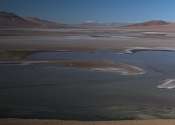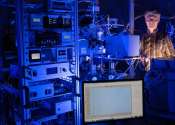Last update:
Astrobiology news

Microscopy reveals signs of life in Earth's extremes, boosting search for alien life
New research from Portland State University focused on identifying signs of life—biosignatures—in extreme environments here on Earth. Researchers investigated whether microbial active motion (e.g., swimming), morphology, ...
Astrobiology
Apr 4, 2025
0
31

Unique bacteria that survive by employing multicellular behavior offer clues to life's evolution
In a recent study, researchers gained new insight into the lives of bacteria that survive by grouping together as if they were a multicellular organism. The organisms in the study are the only bacteria known to do this in ...
Astrobiology
Apr 2, 2025
0
60

Lunar polar regions could have microbes, modeling study suggests
Could microbes survive in the permanently shadowed regions (PSRs) of the moon? This is what a recent study presented at the 56th Lunar and Planetary Science Conference (LPSC 2025) hopes to address as a team of researchers ...
Astrobiology
Apr 1, 2025
0
57

How can we find cryovolcanoes on Europa?
In the 1970s, NASA's Voyager probes passed through Jupiter's system and snapped pictures of its largest moons, also known as the Galilean moons. These pictures and the data they gathered offered the first hints that a global ...
Astrobiology
Apr 1, 2025
0
2

How to engineer microbes to enable us to live on Mars
A field known as synthetic biology has become one of the most highly anticipated in science. Its outputs range from golden rice, which is genetically engineered to provide vitamin A, to advances stemming from the Human Genome ...
Space Exploration
Apr 1, 2025
0
18

A step towards life on Mars? Lichens survive Martian simulation in new study
For the first time, researchers have demonstrated that certain lichen species can survive Mars-like conditions, including exposure to ionizing radiation, while maintaining a metabolically active state.
Astrobiology
Apr 1, 2025
3
396

NASA's Curiosity rover has found the longest chain carbon molecules yet on Mars
NASA's Curiosity Mars rover has detected the largest organic (carbon-containing) molecules ever found on the red planet. The discovery is one of the most significant findings in the search for evidence of past life on Mars. ...
Astrobiology
Mar 31, 2025
0
23

Could Venus host life? The Venus life equation can help us find out
What drives us to send probes throughout the solar system and rovers and landers to Mars? It's not cheap, and it's not easy. It's because we live inside a big, natural puzzle, and we want to understand it. That's one reason. ...
Astrobiology
Mar 28, 2025
0
12

Experiment shows theory describing formation of interstellar benzene does not actually produce benzene
Astrophysicists at the University of Colorado's JILA, National Institute of Science and Technology, have conducted an experiment to produce benzene the way theories have predicted it is produced in interstellar space and ...

One day we might seed the universe with life. But should we?
Suppose humanity was faced with an extinction-level event. Not just high odds, but certain-sure. A nearby supernova will explode and irradiate all life, a black hole will engulf the Earth, a Mars-sized interstellar asteroid ...
Astrobiology
Mar 27, 2025
0
61

Fluorescent caves could explain how life persists in extraterrestrial environments
Deep below Earth's surface, rock and mineral formations lay hidden with a secret brilliance. Under a black light, the chemicals fossilized within shine in brilliant hues of pink, blue and green. Scientists are using these ...
Astrobiology
Mar 25, 2025
0
55

Organic molecules of unprecedented size discovered on Mars
Scientists analyzing pulverized rock onboard NASA's Curiosity rover have found the largest organic compounds on the red planet to date. The finding, published Monday in the Proceedings of the National Academy of Sciences, ...
Astrobiology
Mar 24, 2025
1
571

Using algorithms to help find life on icy ocean worlds
Scientists have long thought that our solar system's ocean worlds, such as Jupiter's moon Europa and Saturn's moon Enceladus, may harbor extraterrestrial life in the form of microbes. But detecting it could be a challenge ...
Astrobiology
Mar 24, 2025
0
77

Extremely Large Telescope could sense hints of life at Proxima Centauri in just 10 hours, simulations suggest
The Extremely Large Telescope (ELT), currently under construction in northern Chile, will give us a better view of the Milky Way than any ground-based telescope before it. It's difficult to overstate how transformative it ...
Astronomy
Mar 21, 2025
0
267

A Dyson swarm made of solar panels would make Earth uninhabitable, suggests study
As civilizations become more and more advanced, their power needs also increase. It's likely that an advanced civilization might need so much power that they enclose their host star in solar energy-collecting satellites. ...
Astrobiology
Mar 20, 2025
4
102

Molecule's 'fingerprint' may help explain formation of life on Earth
The chemical element sulfur is essential for all lifeforms and is a building block of proteins and amino acids. By studying sulfur-based molecules in space, scientists are working to understand the chemical processes that ...
Astrobiology
Mar 20, 2025
0
39

Surprisingly, some Dyson spheres and ringworlds can be stable
In the realm of science fiction, Dyson spheres and ringworlds have been staples for decades. But it is well known that the simplest designs are unstable against gravitational forces and would thus be torn apart. Now a scientist ...

Study reveals white dwarfs could host life-supporting planets
Florida Tech's Caldon Whyte is two years into a lengthy universe exploration to earn his Ph.D. in space sciences. After graduating with a Bachelor's degree in astrobiology in 2023, he's fascinated by white dwarf stars—the ...
Astrobiology
Mar 18, 2025
0
70

Why we are so scared of space—and how this fear can drive conspiracy theories
There are many home-grown problems on Earth, but there's still time to worry about bad things arriving from above. The most recent is the asteroid 2024 YR4, which could be a "city killer" if it hits a heavily populated area ...
Astrobiology
Mar 18, 2025
0
0

How radiation from black holes could have a nurturing effect on life
At the center of most large galaxies, including our own Milky Way, sits a supermassive black hole. Interstellar gas periodically falls into the orbit of these bottomless pits, switching the black hole into active galactic ...
Astronomy
Mar 17, 2025
0
35
More news

Signs of alien life may be hiding in these gases

How humans can reinvent themselves to live on other worlds

Ancient beaches testify to long-ago ocean on Mars

Sulfur may be a new tool for finding alien life
Other news

Young plants' vulnerability linked to growth-energy trade-off

Artificial sweetener shows surprising power to overcome antibiotic resistance

Scientists reveal new toxin that damages the gut

Ancient lakes and rivers unearthed in Arabia's vast desert

Hot Schrödinger cat states created

Planarian worms can regenerate into a more youthful version of themselves

Beyond photorespiration: A systematic approach to unlocking enhanced plant productivity

Massive Jupiter storm churns ammonia deep into planet's atmosphere

Bacteria's viral defense mechanism linked to antibiotic resistance

Honda to test renewable tech in space soon























































